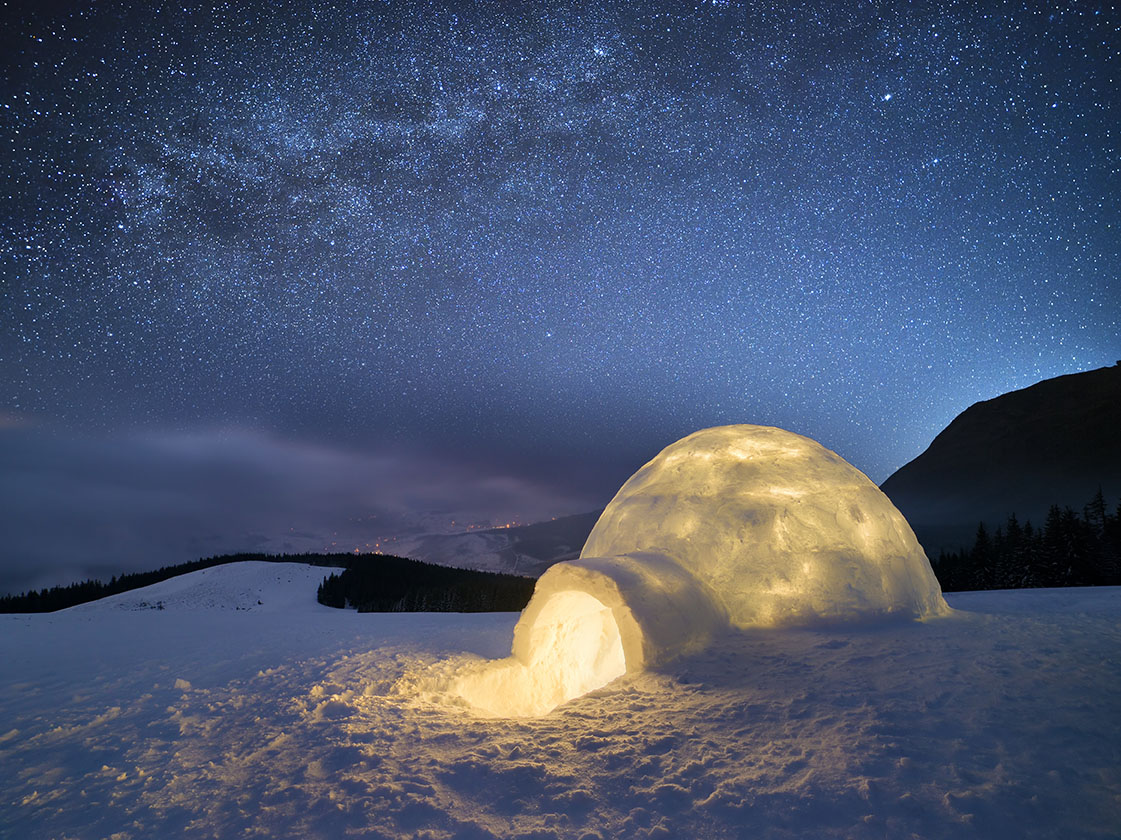
< Back
igloo
Definition
An igloo is a dome-shaped hut made of snow and ice. It is a type of shelter that is used by the Inuit people of the Arctic.
Igloos are built by stacking blocks of snow on top of each other. The blocks are cut into a specific shape so that they fit together tightly. This helps to keep the igloo warm and dry.
The walls of an igloo are typically about 2 feet thick. The roof is about 4 feet thick. This helps to insulate the igloo and keep it warm.
Igloos have a small opening at the top that allows smoke from a fire to escape. The fire is used for cooking and warmth.
Igloos are temporary shelters. They are usually only used for a few days or weeks at a time. When the snow melts, the igloo collapses.
Igloos are very efficient at keeping people warm. The snow blocks trap heat and reflect it back inside the igloo. This helps to keep the temperature inside the igloo around 32 degrees Fahrenheit, even when the temperature outside is below freezing.
Igloos are also very strong. They can withstand winds of up to 100 miles per hour. This is because the snow blocks are tightly packed together and they form a strong structure.
Igloos are a very ingenious way to survive in the harsh Arctic environment. They are warm, dry, and strong, and they can be built quickly and easily.
How can the word be used?
The igloo was made of blocks of snow that were cut from the snow.

Different forms of the word
There are no other forms of the word "igloo". It is a noun that refers to a dome-shaped house made of snow or blocks of ice. It is commonly used by the Inuit people of the Arctic. The word "igloo" is derived from the Inuktitut word "igdlu", which also means "house".
The word "igloo" is spelled the same way in all forms, singular and plural. There are no abbreviations or nicknames for the word "igloo".
Etymology
The word "igloo" is derived from the Inuktitut word "igdlu", which means "house". The Inuktitut language is spoken by the Inuit people of the Arctic.
The word "igdlu" is made up of the following parts:
"ig" means "house".
"dlu" means "snow".
Question
Who lives in an igloo?
AQA Science Exam Question and Answer
Question:
Explain the scientific principles behind the construction and thermal properties of igloos, detailing how their unique design and use of materials help maintain a warmer interior temperature in cold Arctic environments, and discuss the cultural significance of igloos for indigenous communities.
Answer:
Igloos are traditional shelters used by indigenous Arctic communities, known for their remarkable ability to provide warmth and insulation in harsh cold climates. The science behind their construction and thermal properties lies in their ingenious design and utilisation of natural materials.
Igloos are typically made from blocks of compacted snow, creating a dome-shaped structure. This shape minimises the surface area exposed to the cold outside air, reducing heat loss through conduction. The snow blocks act as an effective insulator due to the air trapped between them, preventing heat from escaping.
The use of snow as a building material also benefits from its high albedo, reflecting sunlight and reducing solar heat gain, which is counterintuitive but crucial in the Arctic environment where retaining heat is the primary goal.
Igloos hold cultural significance for indigenous communities, serving as vital shelters that have protected generations from extreme cold. Beyond their practicality, igloos represent a deep connection between people and their environment, showcasing centuries of knowledge about natural materials and effective design for survival.
In conclusion, the construction and thermal properties of igloos are rooted in scientific principles that maximize insulation and heat retention. Their design, coupled with the use of snow as a building material, highlights the ingenuity of indigenous communities in creating effective shelters for extreme environments. The enduring cultural significance of igloos underscores their importance not only as functional structures but also as symbols of resilience and tradition.